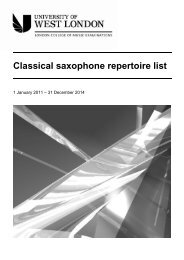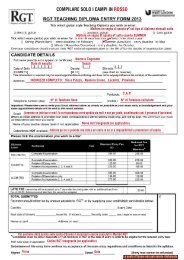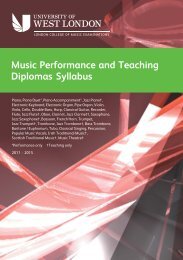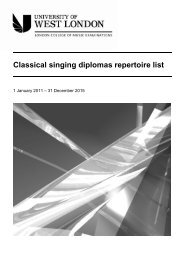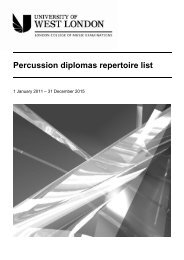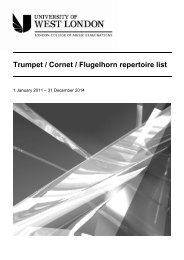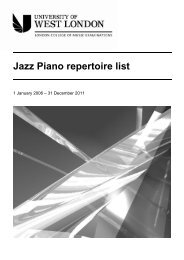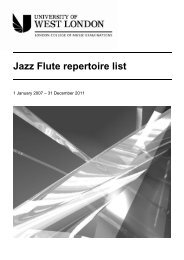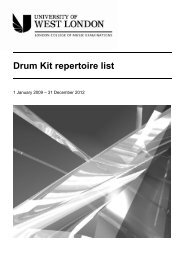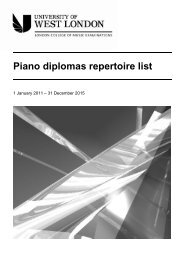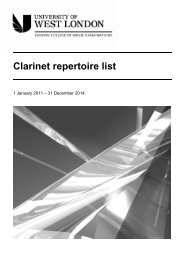LCM Exams - Trombone Grades repertoire list - esamilcm.it
LCM Exams - Trombone Grades repertoire list - esamilcm.it
LCM Exams - Trombone Grades repertoire list - esamilcm.it
- No tags were found...
Create successful ePaper yourself
Turn your PDF publications into a flip-book with our unique Google optimized e-Paper software.
<strong>Trombone</strong> <strong>repertoire</strong> <strong>list</strong>1 January 2011 – 31 December 2014
TROMBONE2011-2014ContentsPageIntroduction ......................................................................... 3<strong>LCM</strong> Publications ................................................................ 3Related Examinations ......................................................... 3Grade 1 ............................................................................... 4Grade 2 ............................................................................... 6Grade 3 ............................................................................... 8Grade 4 ............................................................................... 10Grade 5 ............................................................................... 12Grade 6 ............................................................................... 14Grade 7 ............................................................................... 16Grade 8 ............................................................................... 18Viva Voce ............................................................................ 20Aural Tests .......................................................................... 22This <strong>repertoire</strong> <strong>list</strong> should be read in conjunction w<strong>it</strong>h the Syllabus forGraded and Leisure Play Examinations in Music Performance. Copiesare available free of charge from <strong>LCM</strong> Examinations (tel: 020 8231 2364)or from local representatives, or on uwl.ac.uk/lcmexams.Leisure Play examinations are also available, for candidates who wish toplay pieces only. Please see Section 5 of the syllabus for details.This <strong>repertoire</strong> <strong>list</strong> is valid from 1 January 2011 until 31 December 2014.1
<strong>LCM</strong> ExaminationsDirector of ExaminationsJohn Howard BA PhDChief Examiner in MusicPhilip Aldred BEd F<strong>LCM</strong>Univers<strong>it</strong>y of West London<strong>LCM</strong> ExaminationsSt Mary’s RoadEalingLondonW5 5RFtel: +44 (0)20 8231 2364fax: +44 (0)20 8231 2433email: lcm.exams@uwl.ac.ukuwl.ac.uk/lcmexams© Copyright 2011 by the Univers<strong>it</strong>y of West London, <strong>LCM</strong> Examinations2
IntroductionThis syllabus is designed for tenor trombone players.Candidates may use treble clef ed<strong>it</strong>ions of pieces (where available). Where scores are not available in the requiredclef, a manuscript transpos<strong>it</strong>ion is allowed, but e<strong>it</strong>her the candidate or the accompanist must perform from anoriginal published copy. Sight reading tests will be presented in bass clef.AcknowledgementGrateful thanks are due to Ray Bidwell, the principal syllabus compiler.<strong>LCM</strong> PublicationsThe following <strong>LCM</strong> Publications are relevant to this syllabus:• Specimen Aural Tests (revised 2006) (LL189)• <strong>LCM</strong> Aural Handbook: A Practical Guide to Teaching and Preparing for <strong>LCM</strong> Aural Tests (LL205)<strong>LCM</strong> Publications are distributed by Music Exchange (tel: 0161 946 9301; email: mail@music-exchange.co.uk).A complete <strong>list</strong> of t<strong>it</strong>les may be found on their webs<strong>it</strong>e – www.music-exchange.co.ukRelated Examinations<strong>LCM</strong> Examinations offers examinations in a wide range of subjects, covering classical, jazz, pop/rock andtrad<strong>it</strong>ional music genres. The following syllabuses may also be of interest.Graded and leisure play examinations for:• French Horn, Trumpet / Cornet / Flugelhorn, Bar<strong>it</strong>one / Euphonium, Tuba.• Jazz Trumpet, Jazz <strong>Trombone</strong>.Performance diplomas (four levels) and teaching diplomas (three levels) for:• French Horn, Trumpet / Cornet / Flugelhorn, <strong>Trombone</strong>, Bass <strong>Trombone</strong>, Bar<strong>it</strong>one / Euphonium, Tuba.• Jazz Trumpet, Jazz <strong>Trombone</strong>.A flexible Ensemble syllabus is also available, catering for all types of ensemble from duets and trios up to concertbands and brass bands. Six levels are offered, ranging from <strong>Grades</strong> 1-2 to Dip<strong>LCM</strong> standard.Syllabuses are available free of charge from the <strong>LCM</strong> <strong>Exams</strong> office or from local representatives, or may bedownloaded from the <strong>LCM</strong> <strong>Exams</strong> webs<strong>it</strong>e.3
TROMBONE: GRADE ONEComponent 1 - Technical Work15 marksFLEXIBILITYCREES & GANE No.1.6 OR 1.7 from How Trombonists Do It(Brass Wind)ORRIDGEON No.1 from How Low Brass Do It (Brass Wind)SCALES AND ARPEGGIOS (ascending and descending, from memory)(suggested tempo: m.m. crotchet = 60 when played in quavers)Scales and Arpeggios in the following keys and ranges.Scales to be played both tongued and w<strong>it</strong>h legato tonguing.Arpeggios to be played tongued only.Keys1 octavemelodic OR harmonic(candidate’s choice)Bb majorC minor Component 2 - Performance60 marksPerformance of three pieces, one from each <strong>list</strong>: A, B and C.LIST ABOURGEOIS No.1 OR No.2 from Splinters of Bone (Brass Wind)EDNEY Fanfare OR Tinker’s Tale from Melodic Studies for <strong>Trombone</strong>, Book 2 (Brass Wind)ENDRESEN No.1 from Supplementary Studies for <strong>Trombone</strong> (Studio Music)GREGSON Thoughtful Prelude from 20 Supplementary Tunes for Beginner Brass (Brass Wind)NIGHTINGALE No.1 OR No.3 from Eazy Jazzy ‘Tudes (Warwick)LIST BBARRATT Curtain Raiser OR Fanfare from Bravo! <strong>Trombone</strong> (Boosey & Hawkes)CORNISH Blow Thy Horn, Hunter from The Magic <strong>Trombone</strong> (Boosey & Hawkes)DIABELLI The Joker from The Magic <strong>Trombone</strong> (Boosey & Hawkes)FITZENHAGEN Air Slave from First Book of <strong>Trombone</strong> Solos (Faber)GELDARD Gavotte from Beginners Please! (Winwood)PEARSON Intrada from First Book of <strong>Trombone</strong> Solos (Faber)TALLIS Canon from The Really Easy <strong>Trombone</strong> Book (Faber)TRAD. The Barley Break from The Magic <strong>Trombone</strong> (Boosey & Hawkes)LIST CBATES Dutchview OR Straight Forward from Keynotes Album for <strong>Trombone</strong> (Brass Wind)BUTTERWORTH Lydian Tune from Up Front Album for <strong>Trombone</strong>, Book 1(Brass Wind)BUTTERWORTH Thai Waltz from Keynotes Album for <strong>Trombone</strong>(Brass Wind)COOMBES Trotting <strong>Trombone</strong> from Keynotes Album for <strong>Trombone</strong> (Brass Wind)GELDARD Square Dance from Beginners Please! (Winwood)GRIEG Ase’s Death from The Really Easy <strong>Trombone</strong> Book (Faber)HOROVITZ Merlin’s Tower from Up Front Album for <strong>Trombone</strong>, Book 1 (Brass Wind)RAMSKILL Homeward Trail OR Sand Dance from Keynotes Album for <strong>Trombone</strong> (Brass Wind)TRAD. Song of the Volga Boatmen from The Magic <strong>Trombone</strong> (Boosey & Hawkes)TRAD. Spanish Air from Bravo! <strong>Trombone</strong> (Boosey & Hawkes)WEDGWOOD Wrap <strong>it</strong> up from Really Easy Jazzin’ About for <strong>Trombone</strong> (Faber)4
Component 3 - Viva Voce7 marksSee pages 20-21.Component 4 - Sight Reading10 marksUp to one minute’s preparation time will be allowed to study the test before playing, during which the candidate may tryparts of the test if they wish.Component 5 - Aural Tests8 marksSee pages 22-26. Specimen tests and a handbook are available (details on page 3).5
TROMBONE: GRADE TWOComponent 1 - Technical Work15 marksFLEXIBILITYCREES & GANE No.2.1 (first four pos<strong>it</strong>ions only) from How Trombonists Do It(Brass Wind)ORRIDGEON No.3 from How Low Brass Do It (Brass Wind)SCALES AND ARPEGGIOS (ascending and descending, from memory)(suggested tempo: m.m. crotchet = 60 when played in quavers)Scales and Arpeggios in the following keys and ranges.Scales to be played both tongued and w<strong>it</strong>h legato tonguing, piano and forte.Arpeggios to be played tongued only, piano and forte.Keys 1 octave melodic AND harmonicC majorAb majorG minor Component 2 - Performance60 marksPerformance of three pieces, one from each <strong>list</strong>: A, B and C.LIST ABOURGEOIS No.4 OR No.5 from Splinters of Bone (Brass Wind)EDNEY Six Shooter Shuffle from Melodic Studies for <strong>Trombone</strong>, Book 2 (Brass Wind)ENDRESEN No.3 OR No.4 from Supplementary Studies for <strong>Trombone</strong> (Studio Music)GREGSON No.5 OR No.8 from 20 Supplementary Tunes for Beginner Brass (Brass Wind)NIGHTINGALE No.2 OR No.6 from Eazy Jazzy ‘Tudes (Warwick)LIST BBACH Air from Bravo! <strong>Trombone</strong> (Boosey & Hawkes)BACH O Sacred Head Sore Wounded from Going Solo (Faber)KUHLAU Arietta from First Book of <strong>Trombone</strong> Solos (Faber)MONTEVERDI Ave Maris Stella from The Magic <strong>Trombone</strong> (Boosey & Hawkes)MOZART Andante Grazioso from The Magic <strong>Trombone</strong> (Boosey & Hawkes)PACHELBEL Saraband from First Book of <strong>Trombone</strong> Solos (Faber)LIST CBARRATT Parasaurolophus OR Hampton Swing from Bravo! <strong>Trombone</strong> (Boosey & Hawkes)BARTOK Slovakian Folk Tune from The Magic <strong>Trombone</strong> (Boosey & Hawkes)BERNSTEIN One Hand, One Heart from The Magic <strong>Trombone</strong> (Boosey & Hawkes)BOYLE Invocation, No.1 from Four Miniatures (Boosey & Hawkes)BRAHMS Love Song from The Magic <strong>Trombone</strong> (Boosey & Hawkes)BULLARD Circus Rock from Circus Skills (Spartan Press)CROSSE Elegy from Up Front Album for <strong>Trombone</strong>, Book 2 (Brass Wind)GELDARD Polka OR Rumba from Beginners Please! (Winwood)GOUT Circus Clowns from Going Solo (Faber)GRIEG Ballad from Going Solo (Faber)GREGSON Processional from Up Front Album for <strong>Trombone</strong>, Book 2 (Brass Wind)LENNON / McCARTNEYYellow Submarine from Winner Scores All for <strong>Trombone</strong> (arr. Lawrance) (Brass Wind)6
MOWAT Hardy Country from Slide Show for <strong>Trombone</strong> (Brass Wind)RAMSKILL Cockles and Mussels from All Jazzed Up (Brass Wind)SIBELIUS Finlandia from Slide Show for <strong>Trombone</strong> (Brass Wind)TRACEY Sundance from Up Front Album for <strong>Trombone</strong>, Book 1 (Brass Wind)TRAD. Men Of Harlech from Winner Scores All for <strong>Trombone</strong> (arr. Lawrance) (Brass Wind)WEDGWOOD Easy Tiger OR Dragonfly from Really Easy Jazzin’ About (Faber)Component 3 - Viva Voce7 marksSee pages 20-21.Component 4 - Sight Reading10 marksUp to one minute’s preparation time will be allowed to study the test before playing, during which the candidate may tryparts of the test if they wish.Component 5 - Aural Tests8 marksSee pages 22-26. Specimen tests and a handbook are available (details on page 3).7
TROMBONE: GRADE THREEComponent 1 - Technical Work15 marksFLEXIBILITYCREES & GANE No.3.1 (pos<strong>it</strong>ions 1-6, page 9) from How Trombonists Do It(Brass Wind)ORRIDGEON No.7 OR No.8 from How Low Brass Do It (Brass Wind)SCALES AND ARPEGGIOS (ascending and descending, from memory)(suggested tempo: m.m. crotchet = 60 when played in quavers)Scales and Arpeggios in the following keys and ranges, to be played tongued and w<strong>it</strong>h legato tonguing, piano andforte:Keys 1 octave a twelfth melodic AND harmonicD majorEb majorG minor D minor Component 2 - Performance60 marksPerformance of three pieces, one from each <strong>list</strong>: A, B and C.LIST ABOURGEOIS No.6 OR No.9 from Splinters of Bone (Brass Wind)EDNEY Mixte Meter OR Tango from Melodic Studies for <strong>Trombone</strong>, Book 2 (Brass Wind)ENDRESEN No.8 OR No.9 from Supplementary Studies for <strong>Trombone</strong> (Studio Music)GREGSON No.16 OR No.17 from 20 Supplementary Tunes for Beginner Brass (Brass Wind)HERING No.6 from 40 Progressive Etudes for <strong>Trombone</strong> (Fischer / Boosey & Hawkes 4427)NIGHTINGALE No.10 OR No.12 OR No.13 from Eazy Jazzy ‘Tudes (Warwick)LIST BGAGNEBIN Sarabande (Leduc / UMP)HAYDN Rondino from Slide Show for <strong>Trombone</strong> (Brass Wind)MOZART March of the Priests from Slide Show for <strong>Trombone</strong> (Brass Wind)MOZART O Isis and Osiris from the Magic Flute, No.2 from A Mozart Solo Album (OUP / Allegro Music)PURCELL Air from Festive Baroque (arr. Van Beringen) (De Haske)TRAD. El Desembre Conglelat from Su<strong>it</strong>e: Creme Catalan from First Book of <strong>Trombone</strong> Solos (Faber)WARLOCK Pavane from Going Solo (Faber)LIST CBART I’d Do Anything from Winner Scores All for <strong>Trombone</strong> (arr. Lawrance) (Brass Wind)BARRATT Round “Square Dance” from Bravo! <strong>Trombone</strong> (Boosey & Hawkes)BULLARD Sentimental Serenade OR Sad Clown from Circus Skills (Spartan Press)CARR Station Master from Top Line Album for <strong>Trombone</strong> (Brass Wind)FAURÉ Pavane from Easy Winners for <strong>Trombone</strong> (Brass Wind)GODDARD Swingin’ from Party Pieces for <strong>Trombone</strong>, <strong>Grades</strong> 2-5 (Spartan Press)GOUT Boogie for ‘bone from Going Solo (Faber)LLOYD WEBBER Memory from First Book of <strong>Trombone</strong> Solos(Faber)MOWAT The Parson’s Nose from Slide Show for <strong>Trombone</strong> (Brass Wind)PEARSON Rag Trade from First Book of <strong>Trombone</strong> Solos (Faber)RAMSKILL Chicago Sunset from All Jazzed Up (Brass Wind)8
RUNSWICK Smoochissimo from The Velvet Slide (Brass Wind)SAINT-SAËNS Royal March of the Lion from The Magic <strong>Trombone</strong> (Boosey & Hawkes)SPARKE Alladale Aria from Skilful Solos for <strong>Trombone</strong> (arr. Sparke) (Anglo Music / De Haske)Component 3 - Viva Voce7 marksSee pages 20-21.Component 4 - Sight Reading10 marksUp to one minute’s preparation time will be allowed to study the test before playing, during which the candidate may tryparts of the test if they wish.Component 5 - Aural Tests8 marksSee pages 22-26. Specimen tests and a handbook are available (details on page 3).9
TROMBONE: GRADE FOURComponent 1 - Technical Work15 marksFLEXIBILITYCREES & GANE No.4.1 from How Trombonists Do It(Brass Wind)ORRIDGEON No.9 OR No.10 from How Low Brass Do It (Brass Wind)SCALES AND ARPEGGIOS (ascending and descending, from memory)(suggested tempo: m.m. crotchet = 72 when played in quavers)Scales and Arpeggios in the following keys and ranges, to be played tongued and w<strong>it</strong>h legato tonguing, piano andforte:Keys 1 octave a twelfth melodic AND harmonicDb majorBb majorAb majorBb minor E minor Chromatic scale starting on C (1 octave)Whole-tone scale starting on C (1 octave)Component 2 - Performance60 marksPerformance of three pieces, one from each <strong>list</strong>: A, B and C.LIST ABOURGEOIS No.11 OR No.13 from Splinters of Bone (Brass Wind)BOURGEOIS No.5 from Bone of Contention (Brass Wind)CLARKE Polish Dance OR Cossack Dance from Featuring Rhythm (Brass Wind)ENDRESEN No.11 OR No.15 OR No.22 from Supplementary Studies for <strong>Trombone</strong> (Studio Music)HERING No.9 OR No.13 from 40 Progressive Etudes for <strong>Trombone</strong> (Carl Fischer / Boosey & Hawkes)NIGHTINGALE No.15 OR No.17 from Eazy Jazzy ‘Tudes (Warwick)REINHARDT No.3 from Selection of Concone Studies for <strong>Trombone</strong> (Elkan-Vogel / UMP)LIST BBACH Polonaise from Bach for <strong>Trombone</strong> (arr. Mowat) (Brass Wind)BYRD The Earl of Salisbury’s Pavane from Just Brass <strong>Trombone</strong> Solos (Chester / Music Sales)CHARPENTIER Prelude to Te Deum from Savoir Faire (arr. Mowat) (Brass Wind)GALLIARD Menuet alternat, No.3 from Solos for the <strong>Trombone</strong> Player (arr. Clark) (G Schirmer / Music Sales)HASSE Bourrée from Festive Baroque (De Haske)MOWAT His Humour from Slide Show for <strong>Trombone</strong> (Brass Wind)WARLOCK Basse Dance from Slide Show for <strong>Trombone</strong> (Brass Wind)LIST CANON. Nobody Knows from A L<strong>it</strong>tle Light Music for <strong>Trombone</strong> (Brass Wind)BOYLE Brazilian Dance, No.4 from Four Miniatures (Boosey & Hawkes)BULLARD Russian Galop from Circus Skills (Spartan Press)FONTANA Sonata from Second Book of <strong>Trombone</strong> Solos (Faber)GERSHWIN Summertime from A L<strong>it</strong>tle Light Music for <strong>Trombone</strong> (Brass Wind)GLYN Stomp from Star Turn (Spartan Press)10
GODDARD Hornpipe from Party Pieces for <strong>Trombone</strong>, <strong>Grades</strong> 2-5 (Spartan Press)GOTTSCHALK Hail Columbia from Second Book of <strong>Trombone</strong> Solos (Faber)GOUT Rough and Ready Rag from Going Solo (Faber)GRAINGER Doctor Who from Winner Scores All for <strong>Trombone</strong> (arr. Lawrance) (Brass Wind)LAWRANCE Aubade OR Dance from Badinage (Brass Wind)MUSSORGSKY The Old Castle from Going Solo (Faber)PARKER Cuban Serenade from Top Line Album for <strong>Trombone</strong> (Brass Wind)RAMSKILL Dancing <strong>Trombone</strong> from All Jazzed Up (Brass Wind)RUNSWICK The Smelter from The Velvet Slide (Brass Wind)Component 3 - Viva Voce7 marksSee pages 20-21.Component 4 - Sight Reading10 marksUp to one minute’s preparation time will be allowed to study the test before playing, during which the candidate may tryparts of the test if they wish.Component 5 - Aural Tests8 marksSee pages 22-26. Specimen tests and a handbook are available (details on page 3).11
TROMBONE: GRADE FIVEComponent 1 - Technical Work15 marksFLEXIBILITYCREES & GANE No.5.1 OR No.5.2 from How Trombonists Do It(Brass Wind)ORRIDGEON No.14 OR No.16 from How Low Brass Do It (Brass Wind)SCALES AND ARPEGGIOS (ascending and descending, from memory)(suggested tempo: m.m. crotchet = 72 when played in quavers)Scales and Arpeggios in the following keys and ranges, to be played tongued and w<strong>it</strong>h legato tonguing, piano andforte:Keys a twelfth 2 octaves melodic AND harmonicG majorA majorC majorG minor C minor Bb minor Chromatic scale starting on F (2 octaves)Whole-tone scale starting on F (2 octaves)Dominant 7th in the key of F (1 octave)Component 2 - Performance60 marksPerformance of three pieces, one from each <strong>list</strong>: A, B and C.LIST ABOURGEOIS No.17 from Splinters of Bone (Brass Wind)BOURGEOIS No.3 OR No.8 from Bone of Contention (Brass Wind)CLARKE Castletown from Featuring Rhythm (Brass Wind)EDNEY No.22 from Melodic Studies for <strong>Trombone</strong>, Book 2 (Brass Wind)ENDRESEN No.34 OR No.46 from Supplementary Studies for <strong>Trombone</strong> (Studio Music)HERING No.24 from 40 Progressive Etudes for <strong>Trombone</strong> (Carl Fischer / Boosey & Hawkes)NIGHTINGALE No.16 OR No.18 OR No.22 from Eazy Jazzy ‘Tudes (Warwick)REINHARDT No.6 OR No.7 from Selection of Concone Studies for <strong>Trombone</strong> (Elkan-Vogel / UMP)LIST BBACH March from Bach for <strong>Trombone</strong> (arr. Mowat) (Brass Wind)BACH Menuett from Festive Baroque (De Haske)HANDEL Lo, See the Conquering Hero from Just Brass <strong>Trombone</strong> Solos (Chester / Music Sales)MOZART Pisen (Song) from Album of Selected Compos<strong>it</strong>ions for <strong>Trombone</strong> Vol.2 (Barenre<strong>it</strong>er)PURCELL Rondo from Slide Show for <strong>Trombone</strong> (Brass Wind)TELEMANN Sonata from Second Book of <strong>Trombone</strong> Solos (Faber)LIST CBALL Arioso from Top Line Album for <strong>Trombone</strong> (Brass Wind)BERLIOZ Chanson du Toreador from Savoir Faire (arr. Mowat) (Brass Wind)CLARKE Fighting Windmills from Sketches from Don Quixote (Brass Wind)CLEWS Misterioso from Four Pieces for <strong>Trombone</strong> (Paterson’s / Music Sales)12
FAURÉ Sicilienne from Going Solo (Faber)GERSHWIN I Got Rhythm from A L<strong>it</strong>tle Light Music for <strong>Trombone</strong> (Brass Wind)GLYN Good News from Star Turn (Spartan Press)GODDARD Daydreams OR Ragamuffin from Party Pieces for <strong>Trombone</strong>, <strong>Grades</strong> 2-5 (Spartan Press)GOUT Blues for ‘bone from Going Solo (Faber)LAWRANCE Badinage from Badinage (Brass Wind)MENDELSSOHN If W<strong>it</strong>h All Your Hearts from First Solos for the <strong>Trombone</strong> or Bar<strong>it</strong>one Player(G Schirmer / Music Sales)NIGHTINGALE The Rippling of the Waves from Lucky Dip (Warwick)NORTON The Hero from Microjazz for <strong>Trombone</strong> (Boosey & Hawkes)VIZZUTTI The Orient from The Enchanted <strong>Trombone</strong> (De Haske)Component 3 - Viva Voce7 marksSee pages 20-21.Component 4 - Sight Reading10 marksUp to one minute’s preparation time will be allowed to study the test before playing, during which the candidate may tryparts of the test if they wish.Component 5 - Aural Tests8 marksSee pages 22-26. Specimen tests and a handbook are available (details on page 3).13
TROMBONE: GRADE SIXComponent 1 - Technical Work15 marksFLEXIBILITYCREES & GANE No.6.6 OR No.6.7 from How Trombonists Do It(Brass Wind)ORRIDGEON No.17 OR No.18 from How Low Brass Do It (Brass Wind)SCALES AND ARPEGGIOS (ascending and descending, from memory)(suggested tempo: m.m. crotchet = 60 when played in semiquavers)Scales and Arpeggios in the following keys and ranges, to be played tongued and w<strong>it</strong>h legato tonguing, piano andforte:Keys a twelfth 2 octaves melodic AND harmonicAb majorGb majorD majorDb majorG# minor E minor D minor Db minor Chromatic scale starting on G (2 octaves)Whole-tone scale starting on G (2 octaves)Dominant 7th in the key of C (2 octaves)Diminished 7th starting on F (2 octaves)Component 2 - Performance60 marksPerformance of three pieces, one from each <strong>list</strong>: A, B and C.LIST ABOURGEOIS No.24 from Splinters of Bone (Brass Wind)BOURGEOIS No.4 OR No.9 OR No.13 from Bone of Contention (Brass Wind)CLARKE Pandora from Featuring Rhythm (Brass Wind)EDNEY No.26 from Melodic Studies for <strong>Trombone</strong>, Book 2 (Brass Wind)HERING No.34 OR No.35 from 40 Progressive Etudes for <strong>Trombone</strong> (Carl Fischer / Boosey & Hawkes)KOPPRASCH Study No.11 from 60 Studies Vol.1 (International Music Company / MDS)NIGHTINGALE No.24 OR No.28 from Eazy Jazzy ‘Tudes (Warwick)REINHARDT No.9 OR No.10 from Selection of Concone Studies for <strong>Trombone</strong> (Elkan-Vogel / UMP)LIST BBACH Anglais from Bach for <strong>Trombone</strong> (arr. Mowat) (Brass Wind)BACH Arioso from Solos for the <strong>Trombone</strong> Player (G Schirmer / Music Sales)GALLIARD First and Second movements from Sonata No.1 in A minor (Peters)PERGOLESI Aria from Second Book of <strong>Trombone</strong> Solos (Faber)PURCELL When I am Laid in Earth from The Baroque <strong>Trombone</strong> (Faber)TELEMANN Die Tapferke<strong>it</strong> from Festive Baroque (De Haske)14
LIST CCLARKE Tale of the Foolish Curios<strong>it</strong>y from Sketches from Don Quixote (Brass Wind)CLEWS Scherzando from Four Pieces for <strong>Trombone</strong> (Paterson’s / Music Sales)CURNOW Fantasy for <strong>Trombone</strong> (Winwood)JACOB First movement from Sonata for <strong>Trombone</strong> (Emerson)MOWAT Bone Idyll from Slide Show for <strong>Trombone</strong> (Brass Wind)NORTON Just that Minute from Microjazz for <strong>Trombone</strong> (Boosey & Hawkes)PARKER Fantango from Jazzed Up Too for <strong>Trombone</strong> (Brass Wind)PROCTOR Slidewalk from On Your Metal (Brass Wind)RAMSKILL Ballad from From Vivaldi to Fats Waller (Brass Wind)RAVEL Pavane pour une Enfant Défunte from Savoir Faire (arr. Mowat) (Brass Wind)RIDOUT Lento and Vivace from Concertino for <strong>Trombone</strong> (Emerson)RIMSKY-KORSAKOVAndante cantabile (incl. cadenza) from <strong>Trombone</strong> Concerto(Brass Wind)VIZZUTTI The Enchanted <strong>Trombone</strong> from The Enchanted <strong>Trombone</strong> (De Haske)Component 3 - Viva Voce7 marksSee pages 20-21.Component 4 - Sight Reading10 marksUp to one minute’s preparation time will be allowed to study the test before playing, during which the candidate may tryparts of the test if they wish.Component 5 - Aural Tests8 marksSee pages 22-26. Specimen tests and a handbook are available (details on page 3).15
TROMBONE: GRADE SEVENComponent 1 - Technical Work15 marksFLEXIBILITYCREES & GANE No.7.5 from How Trombonists Do It(Brass Wind)ORRIDGEON No.21 OR No.22 from How Low Brass Do It (Brass Wind)SCALES AND ARPEGGIOS (ascending and descending, from memory)(suggested tempo: m.m. crotchet = 60 when played in semiquavers)Scales and Arpeggios in the following keys and ranges, to be played tongued and w<strong>it</strong>h legato tonguing, piano andforte:Keys a twelfth 2 octaves melodic AND harmonicBb majorAmajorE majorEb majorBb minor A minor E minor Eb minor Chromatic scales starting on E and Ab (2 octaves)Whole-tone scale starting on A (2 octaves)Dominant 7ths in the keys of D and Eb (2 octaves)Diminished 7ths starting on G and A (2 octaves)Component 2 - Performance60 marksPerformance of three pieces, one from each <strong>list</strong>: A, B and C.LIST ABOURGEOIS No.14 from Bone of Contention (Brass Wind)BOURGEOIS No.1 OR No.4 from Fantasy Pieces for <strong>Trombone</strong> (Brass Wind)HERING No.30 OR No.37 from 40 Progressive Etudes for <strong>Trombone</strong> (Carl Fischer / Boosey & Hawkes)KOPPRASCH No.14 OR No.16 from 60 Studies for <strong>Trombone</strong> Vol.1 (International Music Company / MDS)REINHARDT No.14 from Selection of Concone Studies for <strong>Trombone</strong> (Elkan-Vogel / UMP)LIST BBACH Gigue from Cello Su<strong>it</strong>e No.1 (arr. Lafosse) (Leduc / UMP)BACH Prelude in Ab from Bach for <strong>Trombone</strong> (arr. Mowat) (Brass Wind)GLUCK Che Faro from The Baroque <strong>Trombone</strong> (Faber)HAYDN Adagio from Solos for the <strong>Trombone</strong> Player (G Schirmer / Music Sales)LOEILLET Largo and Allegro from Sonata in A flat (arr. Sturzenegger) (EMR307/Schauer)MARCELLO Andante and Allegro from Sonata in G (International Music Company / MDS)VIVALDI Third and Fourth movements from Sonata No.3 in A minor (EMR325)LIST CBERLIOZ Rec<strong>it</strong>ative and Prayer (Brass Wind)DEBUSSY Le Cake-Walk from Savoir Faire (arr. Mowat) (Brass Wind)FRAZER Hellas for <strong>Trombone</strong> (Studio Music)16
GENZMER Allegro from Sonata for <strong>Trombone</strong> (Peters)GORB 10:45 from A Life in the Day of a <strong>Trombone</strong> (Brass Wind)GREGSON Canzona and Scherzino from Divertimento for <strong>Trombone</strong> (Studio Music)HINDEMITH Allegro moderato maestoso from Sonata for <strong>Trombone</strong> (Schott)HOROVITZ Adam Blues (Novello / Music Sales)KNEALE Blue John (Ravencar / Emerson)LUSHER Concert Variations (Brand / R Sm<strong>it</strong>h)NEWSOME Tenor <strong>Trombone</strong> Rag (Studio Music)PARKER Dances w<strong>it</strong>h Bears from Jazzed Up Too for <strong>Trombone</strong> (Brass Wind)PROCTOR Azure OR Nocturne from On Your Metal (Brass Wind)RACHMANINOV Vocalise from Solos for the <strong>Trombone</strong> Player (G Schirmer / Music Sales)RIMSKY-KORSAKOV Allegro Vivace from Concerto for <strong>Trombone</strong>(Brass Wind)SEROCKI First movement from Sonatina (Moeck EM)SHOSTAKOVICH No.1 from Four Preludes (Musicus / MusT)Component 3 - Viva Voce7 marksSee pages 20-21.Component 4 - Sight Reading10 marksUp to one minute’s preparation time will be allowed to study the test before playing, during which the candidate may tryparts of the test if they wish.Component 5 - Aural Tests8 marksSee pages 22-26. Specimen tests and a handbook are available (details on page 3).17
TROMBONE: GRADE EIGHTTheory of Music Grade Five must have been passed (see Regulations in the syllabus).Component 1 - Technical Work15 marksFLEXIBILITYCREES & GANE No.9.7 from How Trombonists Do It(Brass Wind)ORRIDGEON No.28 OR No.29 from How Low Brass Do It (Brass Wind)SCALES AND ARPEGGIOS (ascending and descending, from memory)(suggested tempo: m.m. crotchet = 72 when played in semiquavers)Scales and Arpeggios in the following keys and ranges, to be played tongued and w<strong>it</strong>h legato tonguing, piano andforte:Keys a twelfth 2 octaves melodic AND harmonicThe major scales from B - EbThe major scales from E - BbThe minor scales from B - Eb The minor scales from E - Bb Chromatic scales starting on any note E to Bb (2 octaves)Whole-tone scales starting on Bb, F# and E (2 octaves)Dominant 7ths in the keys of B, Db and A (2 octaves)Dominant 7ths in the keys of Gb, G and Ab (a twelfth)Diminished 7ths starting on any note from E to Bb (2 octaves)Component 2 - Performance60 marksPerformance of three pieces, one from each <strong>list</strong>: A, B and C.LIST ABLAZHEVICH No.66 OR No.67 from Studies in Clefs (IMC 1623 / MDS)BOURGEOIS No.2 OR No.3 from Fantasy Pieces for <strong>Trombone</strong> (Brass Wind)BOURGEOIS No.15 from Bone of Contention (Brass Wind)KOPPRASCH No.36 OR No.44 OR No.46 from 60 Studies for <strong>Trombone</strong>, Vol.2 (IMC / MDS)NIGHTINGALE No.5 OR No.10 from 20 Jazz Etudes (Warwick)LIST BBACH Prelude AND Bourées 1 and 2 from Cello Su<strong>it</strong>e No.3 (arr. Lafosse) (Leduc / UMP)GALLIARD Sonata No.5 in D minor (complete) (Peters H-753e)HAYDN Larghetto for <strong>Trombone</strong> (Winwood)MARCELLO Sonata in F (complete) (IMC 1978 / MDS)PERGOLESI Sinfonia (Marc Reift / MusT)WEBER Romance for <strong>Trombone</strong> (Brass Wind)LIST CCASTEREDE First OR Third movement from Sonatina for <strong>Trombone</strong> (Leduc / UMP)CLIFF Any two movements from Four Sketches for <strong>Trombone</strong> (Studio Music)COOK Bolivar (Boosey & Hawkes)DAVID First and Second movements from <strong>Trombone</strong> Concertino in E flat, Op.4 (Brass Wind)EAST First AND Second movements from Sonatina for <strong>Trombone</strong> (Ricordi LD801)18
GUILMANT Morceau Symphonique Op.88 (Schott)HOLST Concertante for <strong>Trombone</strong> (Warwick)JACOB <strong>Trombone</strong> Concertino (complete) (Emerson E105a)MAHLER Solo from Third Symphony (arr. Mowat) (Brass Wind)ROTA First movement from Concerto (Ricordi)SAINT-SAËNS Cavatine, Op.144 (Brass Wind)SCHUMANN Romance No.1 from Three Romances, Op.94 (IMC / MDS)SEROCKI Second and Third movements from Sonatina (Moeck EM)WIGGINS Caprice for <strong>Trombone</strong> (Kirklees)Component 3 - Viva Voce7 marksSee pages 20-21.Component 4 - Sight Reading10 marksUp to one minute’s preparation time will be allowed to study the test before playing, during which the candidate may tryparts of the test if they wish.Component 5 - Aural Tests8 marksSee pages 22-26. Specimen tests and a handbook are available (details on page 3).19
Viva VoceNotes:1. All questions and answers are verbal. Candidates are not expected to demonstrate on their instrument or tosing; but they may choose to do so if they feel that this would clarify their answer.2. There is no set form of words, or number of questions. Examiners are encouraged to conduct the tests in aflexible and conversational manner. The number of questions asked, and the content of the questions, maydiffer from candidate to candidate. However, the prime focus for the Viva Voce will always be the musicperformed in the Performance section of the exam.3. The knowledge required for the Viva Voce is cumulative for <strong>Grades</strong> 1-8; i.e. any knowledge required in earliergrades is required for later grades.4. Although accuracy and appropriateness of response are the principal cr<strong>it</strong>eria of assessment, examiners willalso look for articulacy, use of correct terminology, and a sense of engagement w<strong>it</strong>h, and understanding of, themusic performed.Requirements:GRADES 1 AND 2Candidates should be able to:• name, and explain the meaning of, all basic notational elements in the music performed in the Performancecomponent of the exam, including: staff, bars and bar-lines, clefs, p<strong>it</strong>ches of individual notes, rhythmic valuesof notes and rests (including dotted notes), key and time signatures, accidentals, dynamics, articulationmarkings, phrases, ornaments, and any add<strong>it</strong>ional markings;• explain which is their favour<strong>it</strong>e piece and why;• assign simple descriptive words to pieces to describe their mood ('happy', 'sad', 'bouncy', 'jazzy', 'gentle',etc.)GRADE 3In add<strong>it</strong>ion to the requirements for <strong>Grades</strong> 1 and 2, candidates may be asked to:• identify intervals up to and including a fifth by numerical value only (e.g. 'second', 'fourth', etc.);• describe the mood or character of pieces using appropriate descriptive terminology ('fast and lively', 'gentleand flowing', 'like a dance', etc.);• identify contrasts of mood w<strong>it</strong>hin pieces;• discuss any pictorial or descriptive element of the music.GRADE 4In add<strong>it</strong>ion to the requirements for <strong>Grades</strong> 1-3, candidates may be asked to:• identify intervals up to and including an octave by numerical value only (e.g. 'fourth', 'seventh', etc.);• demonstrate basic knowledge of composers of the music performed, including their national<strong>it</strong>y andapproximate dates;• discuss their approaches to learning the pieces, and to identify any particular difficulties (musical ortechnical) which were encountered;• demonstrate a basic understanding of the workings of their instrument, and to name <strong>it</strong>s principal const<strong>it</strong>uentparts.20
GRADE 5In add<strong>it</strong>ion to the requirements for <strong>Grades</strong> 1-4, candidates may be asked to:• identify intervals up to and including an octave by number and type (e.g. 'Major 2nd', 'Perfect 4th', etc.);• demonstrate knowledge of basic formal structures (e.g. contrasting or repeated sections);• identify principal modulations (by naming the new key or <strong>it</strong>s relationship to the home key);• identify major and minor chords as occurring in the music (e<strong>it</strong>her as chords or as melodic patterns);• identify the historical period of the music performed (Renaissance, Baroque, etc.).GRADE 6In add<strong>it</strong>ion to the requirements for <strong>Grades</strong> 1-5, candidates may be asked to:• discuss their personal responses to the music performed: the extent to which they like or dislike <strong>it</strong>, or find <strong>it</strong>challenging or rewarding, and why;• approaches to learning the music, including the use of certain techniques, and aspects of interpretation;• identify melodic and harmonic features of the music (e.g. sequence, melodic inversion, circle of 5ths, pedalpoints, etc.);• demonstrate knowledge of formal structures (e.g. ternary, binary, rondo etc.);• demonstrate a self-cr<strong>it</strong>ical awareness of their own performance, indicating to the examiner which aspects oftheir performance they were happy or unhappy w<strong>it</strong>h, and why.GRADE 7In add<strong>it</strong>ion to the requirements for <strong>Grades</strong> 1-6, candidates may be asked to:• identify more complex chords, including sevenths and dissonances, as occurring in the music (e<strong>it</strong>her aschords or as melodic patterns);• identify cadences;• give basic biographical information about the composers of the music performed;• demonstrate awareness of the historical and sty<strong>list</strong>ic context of the music;• demonstrate a widening musical awareness a l<strong>it</strong>tle beyond the music performed.GRADE 8In add<strong>it</strong>ion to the requirements for <strong>Grades</strong> 1-7, candidates may be asked to:• demonstrate knowledge of other music by the same composers;• identify any interval by number and type;• discuss w<strong>it</strong>h the examiner a range of issues arising from the music performed, demonstrating evidence of arounded musical awareness, in terms both of the <strong>repertoire</strong> <strong>it</strong>self, and the candidate's response to <strong>it</strong> as aperformer.21
Aural TestsNotes:1. GRADE 1 TEST 1(b); GRADE 3 TEST 2(b): where a candidate wishes to respond to e<strong>it</strong>her of these tests inthe alternative manner as specified, the examiner must be informed in advance of the tests beingadministered. This may be done e<strong>it</strong>her via the Centre representative or attendant on the day (in advance of theexamination), or by the candidate (in the examination, in advance of the tests).2. In tests where the identification of note values (rhythmic values) is required, such as Grade 2, test 1(c),candidates are required to respond by <strong>list</strong>ing the rhythmic values in the order in which they occur in theextract, e.g. 'minim, crotchet, crotchet' or 'minim, four quavers'.3. In tests where a sung response is required, candidates may use any clear and appropriate syllable or vowelsound (e.g. 'ah', 'la', 'oo', etc.) They may also hum or whistle. Candidates may request tests to be transposed ifrequired by their vocal range. Candidates may play back such tests on their instrument if they prefer; in thiscase, examiners must be informed prior to the administration of the tests (see note 1 above).4. In tests where responses describing p<strong>it</strong>ch are required, candidates may use letter-names (A, B, C, etc.), tonicsol-fa (doh, re mi, etc.), or number (1, 2, 3, etc., or 1st, 2nd, 3rd, etc.) (Where a minor key is used, <strong>it</strong> will beassumed that doh=tonic.)5. Please note that from Grade 2 onwards, candidates are required to beat time (i.e. conduct), NOT to tap or clapthe pulse. They may join in during the in<strong>it</strong>ial playing, or a second playing may be given.6. Candidates may request any test to be given one repeat playing w<strong>it</strong>hout loss of marks.7. Please note that in all cases, examiners will use a piano to conduct the tests. Examiners will askcandidates to stand or s<strong>it</strong> in such a pos<strong>it</strong>ion that they cannot see the piano keyboard.8. Please note that the printed wording is a guide only. Examiners are encouraged to conduct the tests in aconversational manner.Requirements:GRADE 1RhythmA short harmonised passage, of approximately 6-8 bars in length, will be played. The passage will be ine<strong>it</strong>her 2/4 or 3/4 time. Candidates will be asked to:1 (a) identify the time signature as “2” or “3” time (2 marks).1 (b) clap or tap on each pulse beat, in time, in 2 or 3 time, accenting the first beat of each bar, as the examinerplays the passage again (2 marks).Candidates may elect to respond to tests 1(a) and 1(b) in reverse order. In this case, the examiner shouldbe informed in advance of the tests being administered (see Note 1 above).P<strong>it</strong>chTwo notes of different p<strong>it</strong>ches will be played, one after the other. Candidates will be asked to:2 (a) identify as “first” or “second” which of the two notes is EITHER the higher OR the lower, at the examiner'sdiscretion (1 mark).The two notes will be played again. Candidates will be asked to:2 (b) sing back one of the two notes (EITHER the first OR the second, at the examiner's discretion) (1 mark).The key-chord of a major key will be played, followed by a short unharmonised melody in the same key, ofapproximately 4 bars in length. The examiner will stop playing before the final (tonic) note. The candidatewill be asked to:2 (c) sing clearly the missing final tonic (2 marks).22
GRADE 2RhythmA short harmonised passage, of approximately 8 bars in length, will be played. The passage will be ine<strong>it</strong>her 3/4 or 4/4 time. Candidates will be asked to:1 (a) identify the time signature as "3" or "4" time (1 mark).1 (b) beat (conduct) time, w<strong>it</strong>h a clear beat-shape (conducting pattern), in time w<strong>it</strong>h the examiner’s playing, asthe examiner plays the passage again (1 mark).The examiner will select one bar from the passage, and will play <strong>it</strong> in an unharmonised version.Candidates will be asked to:1 (c) identify and describe the note values (rhythmic values of the notes) in the bar (2 marks).P<strong>it</strong>chA major or minor triad will be played, followed by one note taken from the triad. Candidates will be askedto:2 (a) identify the note as “bottom, middle or top” OR “Doh, Mi or Soh” OR “root, 3rd or 5th” (candidate's choice)(1 mark).The triad will be played again. Candidates will be asked to:2 (b) state if the triad is major or minor (1 mark).The key-chord of a major key (C, F, G, and D majors only) will be played, and the key stated, followed bythe first five notes of the scale in ascending order. The examiner will then play any ONE of these notesagain. Candidates will be asked to:2 (c) identify the note, EITHER by letter name OR by tonic sol-fa name OR by number (1, 2, 3, 4 or 5) as electedby the candidate (1 mark).The test will be repeated, using a different example (1 mark).GRADE 3RhythmA short harmonised passage, of approximately 8 bars in length, will be played. The passage will be in 6/8time. Candidates will be asked to:1 (a) beat (conduct) time, w<strong>it</strong>h a clear beat-shape (conducting pattern), 2 beats in the bar (NOT 6 beats in thebar), in time w<strong>it</strong>h the examiner’s playing, as the examiner plays the passage again (1 mark).The candidate will be shown three lines of music (marked 1, 2 and 3), each of which will contain fourindividual bars of music in 6/8 time (marked a, b, c and d). The examiner will indicate which line of music isbeing used. One of the bars on that line will be played, twice. Candidates will be asked to:1 (b) indicate which bar (a, b, c or d) has been played (1 mark).The test will be repeated, using a different example (1 mark).P<strong>it</strong>chAn interval will be played twice, once w<strong>it</strong>h the p<strong>it</strong>ches sounded successively, and once w<strong>it</strong>h the p<strong>it</strong>chessounded together. The intervals will be restricted to the following: Major 2nd, Major 3rd, Perfect 4th, Perfect5th. Candidates will be asked to:2(a) identify the interval, by numerical value only (2nd, 3rd, 4th, 5th) (1 mark).The test will be repeated, using a different interval (1 mark).The key-chord of a major or minor key (C, G, D, F and Bb majors; A and E minors only) will be played, andthe key stated. A short unharmonised melody, in the same key, of approximately 3 bars in length, will beplayed, twice. Rhythms will be lim<strong>it</strong>ed to crotchets, quavers, minims, dotted minims and semibreves.Candidates will be asked to:2 (b) sing back the melody (3 marks).Candidates may elect to respond to test 2(b) by playing the melody on their instrument, instead of singing.In this case, the examiner should be informed in advance of the tests being administered (see note 1above).23
GRADE 4RhythmA short harmonised passage, of approximately 8 bars in length, will be played. The passage will be ine<strong>it</strong>her 2/4, 3/4, 4/4 or 6/8 time. Candidates will be asked to:1 (a) beat (conduct) time, w<strong>it</strong>h a correct and clear beat shape (conducting pattern) according to the timesignature of the music, in time w<strong>it</strong>h the examiner's playing, as the examiner plays the passage again.(Passages in 6/8 time should be conducted w<strong>it</strong>h a 2-beat pattern). (2 marks).A short phrase, of approximately 2 bars in length, taken from the passage, will be played in anunharmonised version, twice. The phrase will include no rhythmic values shorter than a semiquaver, butmay include simple dotted patterns. Candidates will be asked to:1 (b) clap or tap back the rhythm of the phrase (2 marks).P<strong>it</strong>chAn interval will be played twice, once w<strong>it</strong>h the p<strong>it</strong>ches sounded successively, and once w<strong>it</strong>h the p<strong>it</strong>chessounded together. The interval will be restricted to any major, minor or perfect interval up to and includingan octave. Candidates will be asked to:2(a) identify the interval, by numerical value and type (1 mark).The test will be repeated, using a different interval (1 mark).The candidate will be shown three similar versions of a short melody (marked 1, 2 and 3). The versions willdiffer in p<strong>it</strong>ch, but not in rhythm. One of the versions will be played, twice. Candidates will be asked to:2 (b) identify which version was played (2 marks).GRADE 5RhythmA short harmonised passage, of approximately 8 bars in length, will be played. The passage will be ine<strong>it</strong>her 2/4, 3/4, 4/4, 6/8 or 6/4 time. Candidates will be asked to:1 (a) beat (conduct) time, w<strong>it</strong>h a correct and clear beat shape (conducting pattern) according to the timesignature of the music, in time w<strong>it</strong>h the examiner's playing, as the examiner plays the passage again.(Passages in 6/8 or 6/4 time should be conducted w<strong>it</strong>h a 2-beat or 6-beat pattern as appropriate).(2 marks).A short phrase, of approximately 2 bars in length, taken from the passage, will be played in anunharmonised version, twice. Candidates will be asked to:1 (b) identify and describe the note values (rhythmic values of the notes) in the phrase (2 marks).P<strong>it</strong>chAn interval will be played twice, w<strong>it</strong>h the p<strong>it</strong>ches sounded together. The interval may be any major, minor orperfect interval w<strong>it</strong>hin the octave, as well as the augmented 4th / diminished 5th. Candidates will be askedto:2(a) identify the interval, by type and numerical value (1 mark).The test will be repeated, using a different interval (1 mark).The key-chord of a major key will be sounded. A short melody in the same key, of approximately 2 bars inlength, will be played, finishing w<strong>it</strong>h a harmonised cadence (perfect, imperfect, plagal, or interrupted) in thehome key. Candidates will be asked to:2 (b) identify the cadence, e<strong>it</strong>her by <strong>it</strong>s conventional name, or as “finished” (perfect and plagal) or “unfinished”(imperfect or interrupted) (1 mark).The test will be repeated, using a different example (1 mark).24
GRADE 61(a)1(b)1(c)1(d)1(e)Rhythm and P<strong>it</strong>chA harmonised passage, in simple time, of not more than six bars in length, and containing somesyncopated patterns, will be played, twice. Candidates will be asked to:identify the time signature (1 mark).identify whether the passage is in a major or minor key (1 mark).identify, by number and type, any interval w<strong>it</strong>hin the octave, occurring in the melody-line between twosucceeding notes. These p<strong>it</strong>ches will be played again, first as occurring in the melody, and then w<strong>it</strong>h thep<strong>it</strong>ches sounded together (1 mark).A short phrase from the passage, of 1-2 bars in length, will be played again in an unharmonised version.Candidates will be asked to:clap or tap back the rhythm of the phrase (1 mark).identify and describe the note values (rhythmic values) in the phrase (2 marks).P<strong>it</strong>chThe key-chord of a major key will be sounded. A short melody in the same key, of approximately 2 bars inlength, will be played, finishing w<strong>it</strong>h a harmonised cadence (perfect, imperfect, or interrupted) in the homekey. Candidates will be asked to:2 (a) identify the cadence by <strong>it</strong>s conventional name (1 mark).The key-chord of a major key will be sounded, and the key named. A short harmonised passage in thesame key, of approximately 4 bars in length, will be played. The passage will contain one modulation to arelated key (dominant, subdominant, or relative minor), finishing w<strong>it</strong>h a perfect cadence in that key.Candidates will be asked to:2 (b) identify the key into which the passage has modulated, e<strong>it</strong>her by name or by relationship to the home key(candidate's choice) (1 mark).GRADE 71 (a) A harmonised passage of approximately 12 to 16 bars in length, in e<strong>it</strong>her simple or compound time, will beplayed, once. Candidates will be asked a selection of the following:• to identify the time signature• to identify whether the passage is in a major or minor key• to describe the overall dynamics• to describe the basic overall form (this will be lim<strong>it</strong>ed to AB, ABA, AAB, ABAB, AABA) (2 marks).1 (b) The candidate will be given a copy of the score, w<strong>it</strong>hout phrasing, tempo, articulation, or dynamic markings.The passage will be played once again in full; further shorter sections may also be played again.Candidates will be asked a selection of the following:• to suggest an appropriate tempo marking• to describe changes in tempo• to name the key• to describe phrasing patterns• to describe dynamics• to describe articulation• to identify modulations• to identify ornaments• to confirm their description of the form (4 marks).2. The key-chord of a major or minor key will be sounded. A short harmonised passage in the same key, ofapproximately 2 bars in length, will be played, finishing w<strong>it</strong>h a harmonised cadence (perfect, imperfect,plagal, or interrupted) in the home key. Candidates will be asked to:identify the cadence by <strong>it</strong>s conventional name. (1 mark).The test will be repeated, using a different example (1 mark).25
GRADE 81. A harmonised passage of approximately 12 to 16 bars in length, in e<strong>it</strong>her simple or compound time, will beplayed, once. Candidates will be asked a selection of the following:• to identify the time signature;• to identify whether the passage is in a major or minor key;• to suggest an appropriate tempo marking;• to describe and identify any particularly noticeable aspects of the dynamics, phrasing, articulation,modulation, ornamentation, texture, etc. (examiners may play certain extracts from the passage again);• to suggest a musical style (Renaissance, Baroque, Classical, Romantic, Twentieth Century or Modern,Jazz / Popular);• to identify any interval in the melodic line between two successive notes, up to and including a Major10th (the two p<strong>it</strong>ches will be played again, as occurring in the melody);• to clap back, or identify and describe the note values (rhythmic values) of, a short phrase of 1-2 bars induration, taken from the passage and played again in an unharmonised version;• to identify a cadence, taken from the passage, played again by the examiner (4 marks).2. The candidate will be given a copy of the score, w<strong>it</strong>hout phrasing, tempo, articulation, or dynamic markings.The passage will be played once again in full; further shorter sections, of up to 4 bars in length, may alsobe played again, sometimes w<strong>it</strong>h changes in phrasing, tempo, articulation and/or dynamics. Candidates willbe asked a selection of the following:• to name the key• to identify modulations• to identify ornaments• to describe the overall form (in add<strong>it</strong>ion to those specified for Grade 7, these may include ABCA,ABCBA, AA'BA, ABA'B, and similar structures, as well as more organic forms, or forms based onim<strong>it</strong>ative or fugal structures);• to identify simple melodic, rhythmic or harmonic devices, such as sequence, inversion, repet<strong>it</strong>ion, pedalpoints, augmentation / diminution, motivic development, etc.• to identify changes in phrasing, tempo, articulation and/or dynamics, in short passages, of up to 2 barsin length, played in two different styles by the examiner (4 marks).June 201126



